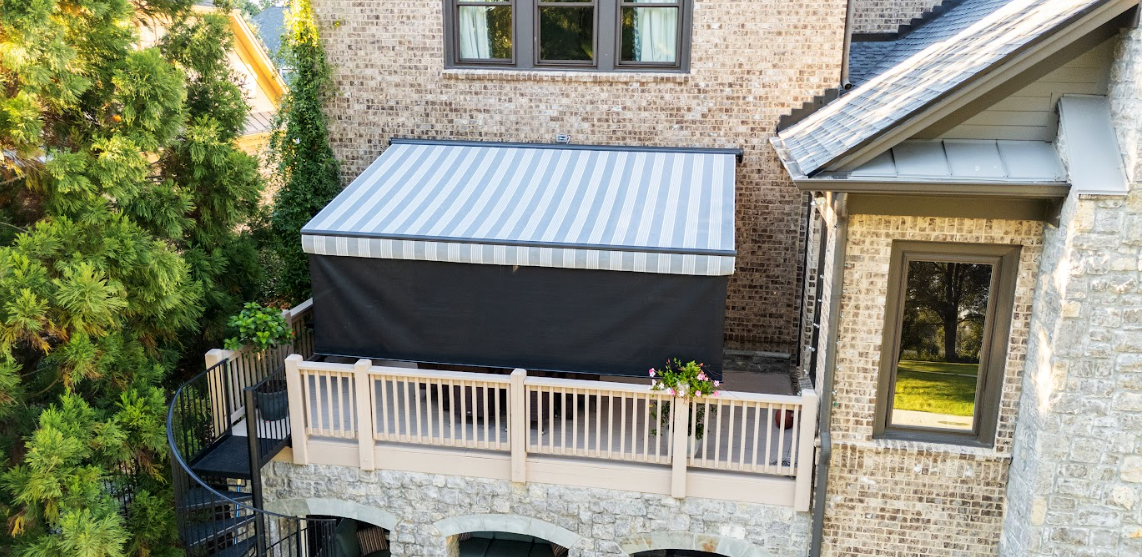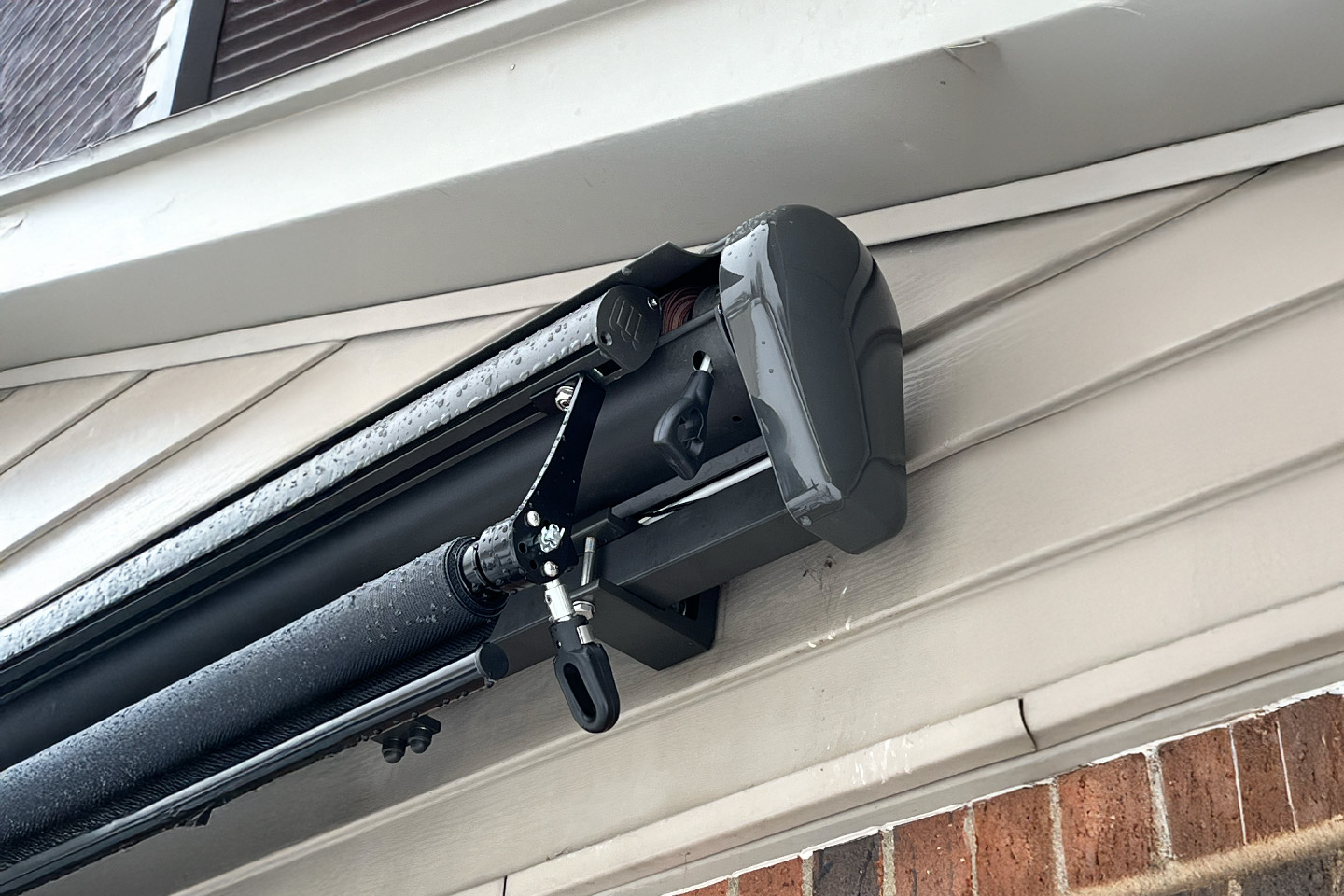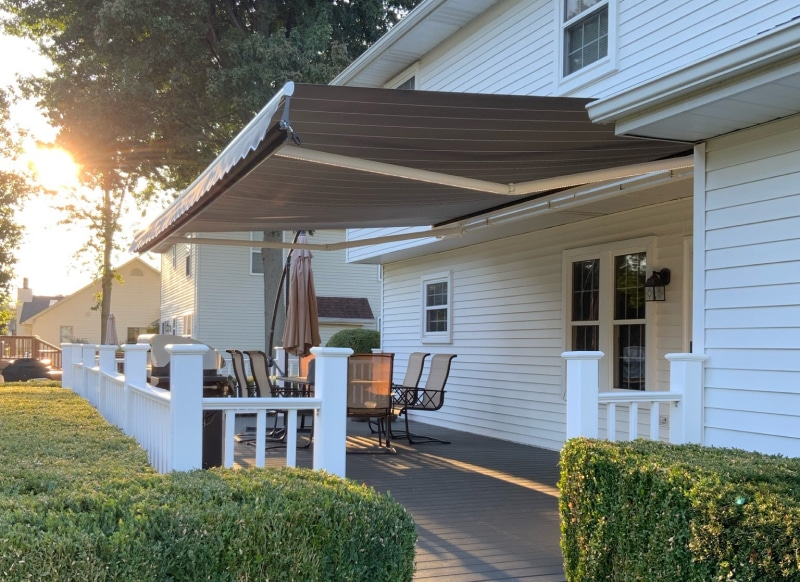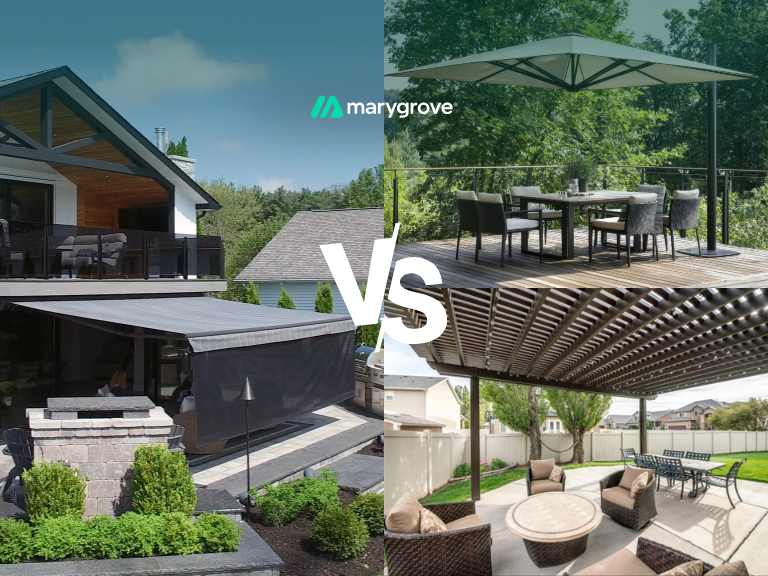Awnings offer the best all-around solution for shade, comfort, and longevity, beating canopies and pergolas in durability, smart features, and daily usability. While pergolas win on style and canopies on portability, awnings provide the most balanced, long-term value for homeowners.
Which Shade Option Should You Choose?
Awnings, canopies, and pergolas each serve a purpose, but awnings stand out as the most balanced option.
They’re durable, weather-smart, low-maintenance, and integrate cleanly with your home. Pergolas offer visual appeal, while canopies are best for short-term, portable shade. Here’s how they stack up at a glance:
- Awnings: Best for year-round comfort, smart controls, and long-term value
- Pergolas: Great for visual appeal and decorative landscaping
- Canopies: Ideal for events, quick setups, and budget needs
If you want shade that thinks for you, adapts to changing weather, and boosts your outdoor lifestyle without constant maintenance, an awning is the clear winner.
And if you’re wondering just how big the difference is across real categories like durability, privacy, and ROI, wait until you see the breakdown.
Start Here: What Exactly Is an Awning, Canopy, and Pergola?
Before choosing your shade solution, it’s important to understand the differences between an awning, canopy, and pergola.
Each brings unique strengths depending on how, and how often, you use your outdoor space.
Awning: Built-In Shade That Works With Your Home

A wall-mounted, semi-permanent structure that extends to block sun and rain. Often retractable and smart-enabled.
Perfect for those who want seamless shade with minimal effort, awnings also help reduce indoor cooling costs by blocking harsh sunlight before it enters the home.
Use Case: Daily shade over your patio or deck that adjusts automatically with weather conditions.
Canopy: Portable and Pop-Up

A freestanding, fabric-covered frame used for temporary shade. Easy to set up, take down, and store. Canopies are ideal for short-term use and offer quick relief from the sun without a permanent setup.
They’re lightweight, budget-friendly, and great for renters or spontaneous gatherings.
Use Case: Quick shade for events, cookouts, or casual outdoor seating.
Pergola: Architectural and Open-Air

A freestanding or attached frame with slatted beams overhead. Offers partial shade and visual charm.
Use Case: Enhances gardens or patios with decorative shade and space for climbing plants.
Each structure serves a unique purpose, but when performance, comfort, and convenience matter most day-to-day, one option consistently stands above the rest.
Face-Off Begins: Breaking Down the Key Differences by Feature
To help you quickly see how awnings, canopies, and pergolas stack up, here’s a side-by-side look at how they perform in key categories.
Below the table, we’ll walk through each factor in more detail.
Now that you’ve seen the big picture, let’s break down each feature to understand why these differences matter in real-life use.
1. Weather Protection: Who Shields You Best?
Most people want protection from sun, rain, and even snow.
- Awning: Offers superior sun and rain protection, especially with wind sensors and smart retraction that respond automatically to the weather. Premium fabrics resist mildew and UV damage.
- Pergola: Open-roof design gives partial shade; only upgraded louvered pergolas offer significant rain protection. Vulnerable in storms unless reinforced.
- Canopy: Provides temporary cover. Often sags under rain if not tensioned perfectly and may blow over in high winds.
Winner: Awning. Smart automation and enclosed casing make it the most weather-resilient. Pergolas can compete when upgraded, but still fall short in storm adaptability.

2. Installation Ease: What Can You Realistically Set Up?
Can you do it yourself or should you hire a crew?
- Awning: Typically requires professional installation and wall mounting. It’s a one-time process that ensures safety, especially when avoiding hazards like electrical wiring or uneven siding.
- Pergola: Installation is complex. Posts must be anchored properly, and DIY projects often result in uneven rafters or unsafe builds. Permits may also be needed depending on your municipality.
- Canopy: Easiest by far. Pop-up versions can be assembled in minutes, though their simplicity comes at the cost of stability and longevity.
Winner: Canopy. Ideal for short-term use. However, awnings offer better value over time with secure, hassle-free performance once installed.
3. Shade Control: Can You Choose Sun or Shade On Demand?
The real magic is when you can adjust your comfort level instantly.
- Awning: A true standout. Retractable at the push of a button, or even voice-activated, awnings allow you to fine-tune shade based on time of day or weather. Adjustable pitch prevents water pooling and enables ideal coverage.
- Pergola: Fixed rafters limit control unless you opt for a motorized louvered system. Even then, manual adjustment or noise in the wind can be issues.
- Canopy: Offers fixed shade with no adjustability. Once set up, that’s what you get, whether or not the sun agrees.
Winner: Awning. With smart controls and precise angle adjustment, awnings give you total command of your outdoor comfort.
4. Aesthetic Appeal: What Looks Like a Natural Extension of Home?
Curb appeal matters, this is part of your home’s first impression.
- Awning: Modern awnings offer a wide range of custom fabrics, frame colors, and sleek designs that blend seamlessly with home exteriors. When matched well, they become an elegant extension of your living space.
- Pergola: Pergolas deliver visual impact. Whether crafted from cedar or powder-coated aluminum, they bring a high-end, architectural vibe, especially when paired with vines, drapes, or integrated lighting.
- Canopy: Functional but limited in design. Most look like event tents or temporary shelters and rarely add to a home’s long-term aesthetic.
Winner: Pergola. The clear visual stunner. But awnings come in a close second, especially for homeowners looking to preserve sightlines and match their home’s exterior without overpowering it.
5. Durability: Which Structure Truly Lasts?

Especially in areas with snow, rain, or strong sun.
- Awning: High-grade awning materials like polyester or acrylic fabrics resist fading, mildew, and snow. Premium retractable models are rated for wind and include protective cassettes for off-season storage.
- Pergola: Can last decades, especially if made from powder-coated aluminum or vinyl. Wood versions require staining and sealing every few years to resist rot and warping.
- Canopy: Typically built for short-term use. Fabric can fade, tear, or sag within 1–3 seasons. Storage bags also tend to rip, creating frustration for long-term use.
Winner: Awning. Combines weather resistance with low maintenance. While pergolas can last, they demand more upkeep and aren’t always built to handle severe climates.
6. Flexibility: Which Option Grows With Your Lifestyle?
Can the structure adapt if you redesign your space or add new features?
- Awning: Fully retractable, available in various sizes, and can be paired with retractable screens, lighting, or smart-home tech. Ideal for growing families or changing backyard layouts.
- Pergola: Some modular designs allow for added drapes, lights, or roof panels, but the core structure remains fixed. Upgrades often require more investment.
- Canopy: What you buy is what you get. Fixed dimensions and limited add-on options make it inflexible beyond initial setup.
Winner: Awning. The most versatile by far. Whether you’re adding a dining space, hot tub, or play area, your awning can adapt along with you.
7. Cost Efficiency: What’s Worth the Spend Long-Term?
Initial cost vs what you get over the years.
- Awning: Sits in the mid-range pricing tier, but offers significant long-term value. It reduces cooling costs, adds resale appeal, and requires minimal upkeep over time.
- Pergola: Often the most expensive upfront, especially when factoring in labor, permits, and optional upgrades like louvered roofs or motorization.
- Canopy: Cheapest to purchase but rarely lasts beyond a few seasons. Replacement parts and frustration add up quickly.
Winner: Awning. Offers the strongest return on investment. While pergolas have visual appeal, they require more maintenance and cost.
Canopies may seem like a deal but are the most expensive long-term if you count replacements.
8. Smart Features: Which Structure Thinks for You?

Weather alerts, app control, voice commands, who’s really “smart”?
- Awning: The gold standard for smart shade. Options like wind sensors, rain detection, and voice/app controls allow it to react in real-time to weather changes, without you lifting a finger.
- Pergola: Some advanced models offer motorized louvers, but few integrate with home automation.
- Canopy: No smart features. It’s entirely manual.
Winner: Awning. The only structure offering a complete smart-home ecosystem. From Alexa integration to auto-retraction in wind, it brings both ease and peace of mind.
9. Privacy & Comfort: Can You Create a True Outdoor Room?
When you want more than shade, you want a sanctuary.
- Awning: Pair it with retractable privacy screens and built-in LED lighting for a true outdoor retreat. Perfect for relaxing evenings, dining, or working from home in comfort.
- Pergola: Often used with curtains or climbing plants to create cozy nooks and visual partitions.
- Canopy: Basic walls may block wind, but lack stability and aesthetic comfort.
Winner: Tie. Pergolas win on charm and ambiance. But awnings are more adaptable, especially in smaller or urban spaces where retractable screens make a huge difference in creating comfort.
10. Portability: What’s Best for Temporary Use or Events?
Sometimes, the goal is simple: shade for the moment.
- Awning: Fixed to your home’s structure, built for permanence.
- Pergola: Large and immobile, meant for lasting architectural presence.
- Canopy: Lightweight, foldable, and ideal for short-term gatherings like tailgates or backyard parties.
Winner: Canopy. It wins here, hands down. But remember, it’s designed for mobility, not durability or long-term living comfort.
Across all ten categories, each structure has its strengths, but some deliver far more versatility, durability, and everyday value than others.
Here’s where the real difference shows up in practice.
So Who Wins? Why Awnings Outperform in Real Life Use

When it comes to daily performance, long-term value, and all-season comfort, awnings clearly take the lead.
Here’s why they outperform:
- Smart Control: Awnings integrate with smart-home systems, voice control, app access, and built-in weather sensors mean they react automatically to sun, wind, or rain.
- Custom Comfort: Adjustable pitch, retractable screens, and LED lighting let you tailor shade and privacy for work, rest, or entertaining.
- Built-In Durability: Premium materials like PTFE resist fading, mildew, and snow. Awnings are wind-rated and built to last over a decade.
- Stress-Free Install: Professionally installed to avoid common issues like poor slope or risky mounting near fixtures, done right the first time.
- Everyday Reliability: From lowering cooling bills to retracting in bad weather, awnings add value without demanding effort.
Compared to the maintenance of pergolas or the fragility of canopies, a well-installed awning, especially one from Marygrove, delivers comfort, control, and peace of mind every day.
Still, there are times when other shade structures make more sense depending on your space, style preferences, or temporary needs.
Let’s take a closer look.
Pergolas and Canopies: When They Do Make Sense
While awnings win for overall versatility, pergolas and canopies still serve meaningful roles:
- Pergolas shine in landscaped spaces where design is the priority. Their open-beam look adds elegance, especially when paired with greenery or draped fabrics.
- Canopies are a go-to for renters, event hosts, or anyone needing quick, portable shade. They’re affordable and easy to set up, but best suited for short-term use.
If you’re after visual impact or mobility without a long-term commitment, these two options can deliver, just know their strengths lie in specific, limited scenarios.
Choosing the right structure depends on how you plan to use your space and what matters most, whether it’s flexibility, aesthetics, or simplicity.
Each option has its place when matched to the right purpose.
The Verdict Is Clear — Go With the Smartest Shade Option
If you’re looking for a shade solution that balances beauty, tech, comfort, and long-term value, retractable awnings stand in a class of their own.
They offer smart-home compatibility, low maintenance, and the flexibility to adapt to your daily life, all while enhancing your home’s style and functionality.
Whether you’re upgrading your patio, creating a relaxing outdoor workspace, or simply trying to beat the heat, an awning does more than provide shade, it transforms how you live outside.

At Marygrove, we’ve spent decades perfecting this experience.
From in-house installation to wind-rated fabrics and voice-controlled automation, every awning we install is built for comfort, built for convenience, and built to last.
Ready to see what smart shade really looks like?
Explore our retractable awning features and discover why thousands of homeowners trust Marygrove to elevate their outdoor lifestyle.


